The work of Viable Cities rests on three pillars that are concretized in Climate City Contract 2030.
Climate investment plans facilitate this work.
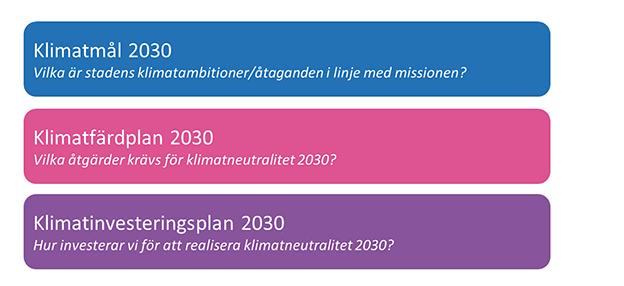
Transitioning to climate-neutral and sustainable cities can save billions and improve citizens' quality of life. Yet the transition is too slow. Climate investment plans are a tool to facilitate the planning of the transition, from current situation to actions and who will pay. A method that makes the transition happen.
Many of the actions needed to drastically reduce greenhouse gas emissions can bring added benefits that contribute to a better quality of life, such as cleaner air, greener surroundings and less noise. While climate action can be virtually free, it can also cost a lot. How much it costs depends on the solutions we choose to use and whether we change our behaviors and habits.
Climate change is already here and is visible and noticeable in different ways, for example, extreme weather events such as heat waves, torrential rain and floods are becoming more frequent. This means that, in addition to reducing emissions, we need to adapt society to cope with these pressures. If we do not invest in climate adaptation, the costs of the consequences of a changing climate could be enormous, for example in terms of destroyed infrastructure. Adaptation measures are costly, but they can also help reduce emissions. One example is trees. Trees capture and absorb greenhouse gases from the air, while their roots stabilize the soil and help to absorb excess water from rainfall. However, it will take time for newly planted trees to contribute, making it important to preserve the trees that already exist.
Viable Cities, together with a growing number of Swedish cities - municipalities and their partners - and several government agencies are exploring how we need to work to manage the transition needed to face the climate crisis, and other societal crises. A key tool in the mobilization is Climate City Contract 2030, a multi-stakeholder agreement to accelerate the transition to reach the goal - climate neutral cities by 2030. At EU level, 112 cities are mobilizing in a similar way for the same mission.
We see three key elements in this work:
Climate investment plans are a five-step methodology that facilitates the planning - and implementation - of the transition.
Research shows that while municipalities have strong political commitment and climate action plans with clear targets, the plans have lacked a description of the total financial resources needed for implementation. It has been unclear how the targets will be achieved.
In response, Viable Cities is developing climate investment plans together with experts from the Stockholm Environment Institute (SEI). It is a five-step methodology that concretely shows what investments are needed, and by whom, to reach climate targets in a municipality's geographical area.
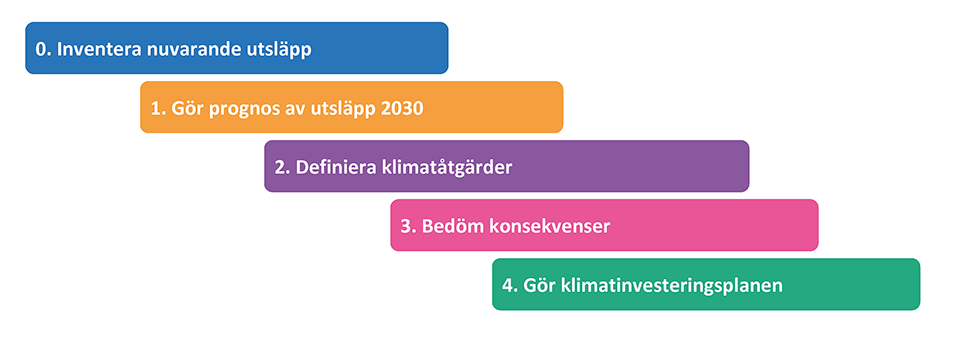
To facilitate the process, a digital tool has been developed - the Viable Cities Finance dashboard (VCF). The tool contains relevant data on climate change adaptation in all 290 municipalities in Sweden. This is not just data from municipal activities, but from all activities within the municipality's geographical area. This includes the climate impact of industries, transportation and heating of buildings, as well as households, community activities and entertainment.
This is why Viable Cities talks about cities and not municipalities. Municipalities cannot meet the challenges on their own. However, they have an essential role in driving the transition by involving and creating opportunities for collaboration between many and raising ambitions and increasing the ability to transition together.
Other public activities - such as regions and national government agencies - also affect emissions at the local level. In Sweden, for example, public transport is the responsibility of the regions. If it does not exist, or if it works poorly, it is difficult to reduce private car traffic. If buses within and between cities run on gasoline or diesel, it can be difficult for cities to meet their transport emissions targets. Therefore, cooperation across many levels of decision-making is also necessary to achieve climate goals.
Fedra Vanhuyse is Finance and Procurement Strategist at Viable Cities and Head of Department for Society, Climate and Policy Support at SEI.
- "The Viable Cities Finance dashboard tool is an easy way to see the potential impact of different climate actions, what they cost and who needs to make the investment," says Fedra Vanhuyse. "If you swap a challenging behavioral change for a technical solution to reduce carbon emissions in the tool, you immediately see how the costs increase drastically.
Below, we go through the five steps of the method, choosing Jönköping as an example city.
But, those billions that a city can save, as mentioned in the introduction, how do you get them? Let's take a municipality, for example Jönköping, and assume that the city has the goal of being climate neutral by 2030. Emissions are currently 3.5 tons per person.
Achieving the target will require a mix of behavioral changes, technological solutions and negative emissions. The latter could include, for example, wetland restoration or technical carbon capture. The tool can currently generate several different scenarios for reaching the target, which can then be evaluated and assessed against each other.
The methodology is based on a baseline picture of emissions in the city - step zero. The tool contains data collected from various sources to show the current situation for all 290 municipalities in Sweden.
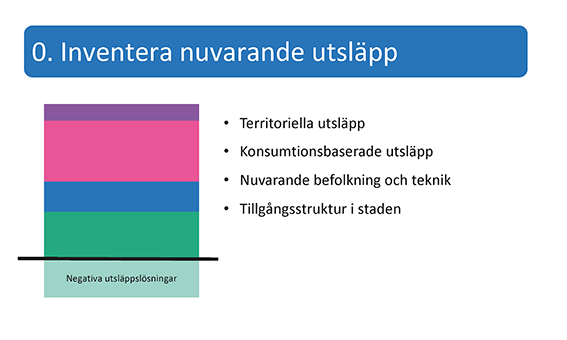
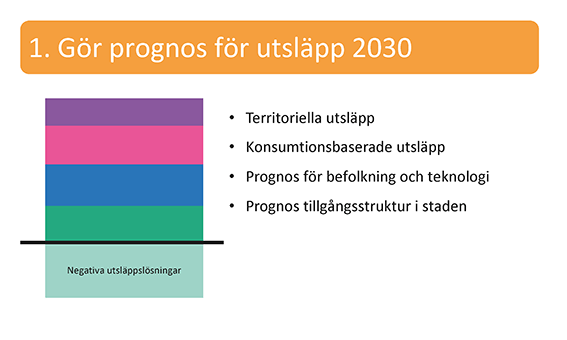
In step one, a projection is made to 2030 - will emissions look like they do now, or will they change? Three different projections can be selected in the tool:
In the case of Jönköping, we assume that emissions will increase slightly (2).
With the tool, the city can then test in step two what actions are needed in different areas to achieve the climate goal. As mentioned earlier, this includes both solutions that require changes in behavior, such as more people cycling instead of driving, or technical solutions, such as solar panels replacing fossil-based heating. The tool calculates not only the investment costs of interventions but also their operational costs.
In the case of Jönköping, a scenario with an emphasis on behavioral changes can achieve the climate target while saving SEK 9 billion. In a scenario with an emphasis on technical solutions, it instead costs SEK 7 billion. There is thus a total cost difference between these two scenarios of SEK 16 billion.
Behavioral changes can include, for example, reduced driving and flying and more energy-efficient households. The savings of EUR 9 billion consist mostly of reduced costs for households. This figure does not include the additional benefits of climate action, such as lower healthcare costs for regions due to better health of citizens. Relying on behavioral changes alone is uncertain, changing habitual patterns is challenging, but by no means impossible.
The technical solutions are costly and can include, for example, investments in electric cars and plug-in hybrids, wind energy, carbon capture and storage (CCS) and hydrogen at industrial sites. The costs are then shared between households, businesses and municipalities.
The tool - the Viable Cities Finance dashboard - allows the city to test different scenarios with mixes of behavioral changes and technological solutions and see how they contribute to achieving the climate goals. Step two provides the basis for the city to formulate its climate roadmap, i.e. to select the actions to be taken to reach zero climate emissions.

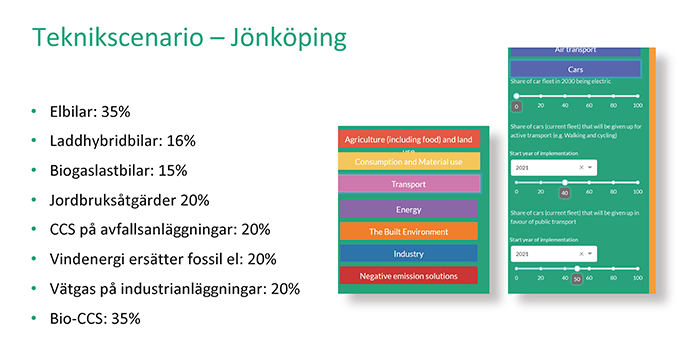
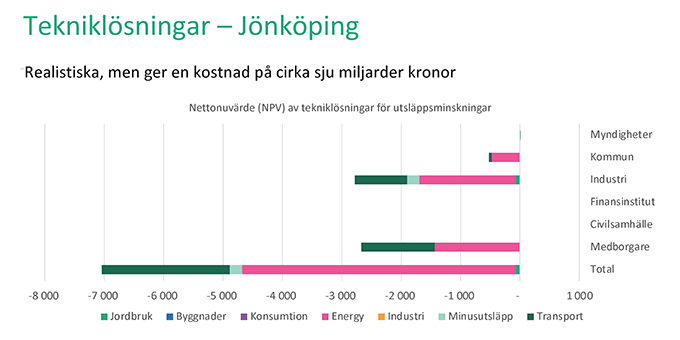
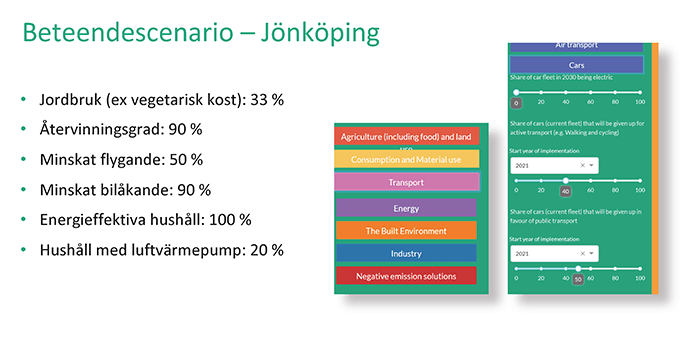
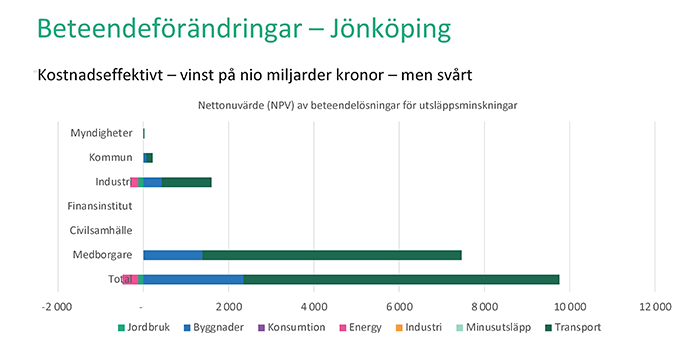
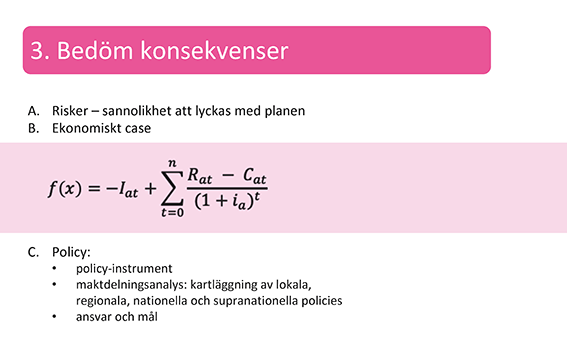
In step three, it is time to see how the climate roadmap will be implemented. This involves assessing the impacts of all actions.
If the analysis shows that the plan is unlikely to work, the city can simply step back and change the mix of interventions, and then redo the impact assessment. Once the analysis shows that the plan is feasible, it is time to make the climate investment plan, step four.
In the case of Jönköping, and in most cities, it is likely to be concluded that a mix of behavioral changes and technological solutions, as well as investments in negative emission solutions are needed to reach climate neutrality.
In the final step, once the city has identified the climate actions needed, the climate investment plan itself is developed. Now the financial capacity of each actor in the plan is assessed, which means finding out how much funding they have. This involves mapping the available financing, i.e. the financial instruments that the actors in the city can use: this includes own financing and financing from other sources, such as grants, bonds, subsidies and loans. The Climate Investment Plan also sets out the conditions for all climate actions, such as the duration of the investment, the interest rate of loans for the investment, and the actor and sector that needs to take the investment.
Once the investments have been made and the climate action launched, a system of monitoring and evaluation should be put in place to assess whether the investments are actually delivering the expected emission reductions. This monitoring should interact with EU reporting rules, such as the EU Taxonomy and the European Sustainability Reporting Standards.
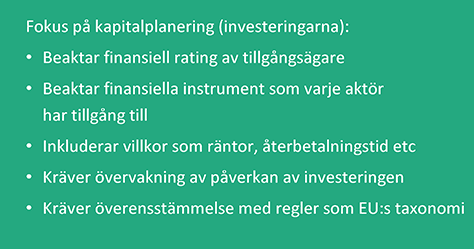
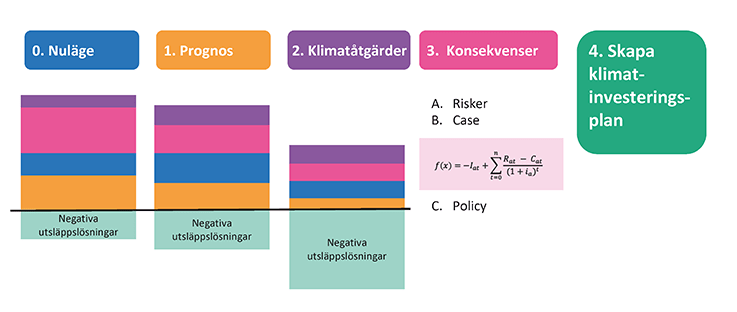
Swedish municipalities already make an investment plan as part of their annual budget process, and some of the investments in their plans are already geared towards supporting urban climate neutrality efforts. However, as mentioned earlier, a municipality cannot face the climate crisis alone, all stakeholders in the city need to be involved as everyone - to different extents - owns assets in the city that contribute to climate emissions. Climate investment plans are the whole city's tool to reach climate neutrality.
The Viable Cities Finance dashboard is a start, providing an overview of what actions are required, by whom, what they cost and what they save. When it comes to formulating the Climate Investment Plan, more detail is of course needed. So it's about counting, not just describing in words.
The plan is not about project financing of individual climate actions, on the contrary. A holistic approach is needed to transition the entire geographical area to climate neutrality. For a city to become climate neutral, assets owned by different actors in the city need to be replaced, renovated or upgraded. Cooperation between all city actors is necessary to agree on the goal of climate neutrality, to design and implement the plans that support the goal, and to gather funding to transform all city assets to support the climate transition.
Another argument for working together in new ways is about the billions in savings, and costs, that arise from the transition. It is not certain that the organization that paid for the effort will get back the investment, the profit may go to a completely different organization. For example, if the municipality of Jönköping takes measures that greatly improve air quality, the healthcare sector, i.e. Region Jönköping County, can save several million kronor by reducing the number of people falling ill with respiratory diseases. To solve this, all actors need to work together.
Creating and implementing the Climate Investment Plan requires a systemic perspective, involving many levels and sectors of society, and new organizational and decision-making structures - including all actors in a city - need to be developed.
The tool, the Viable Cities Finance dashboard, is free for all and in 2024 and beyond, Viable Cities and SEI will continue its development. Among other things, we will explore how the tool can be used at European level and we will improve step three with financing flows and financial capability. The ambition is also to include climate adaptation measures in the tool.
And last but not least, cities also need to know what it will cost them if they do nothing at all. With all the scientific studies available in the field of climate change, we know that this is not an option.
Here you will find the tool, ready to explore.
Here is a user guide to the Viable Cities Finance Dashboard. So far only in English.
A slide presentation of the above content is available for download here.